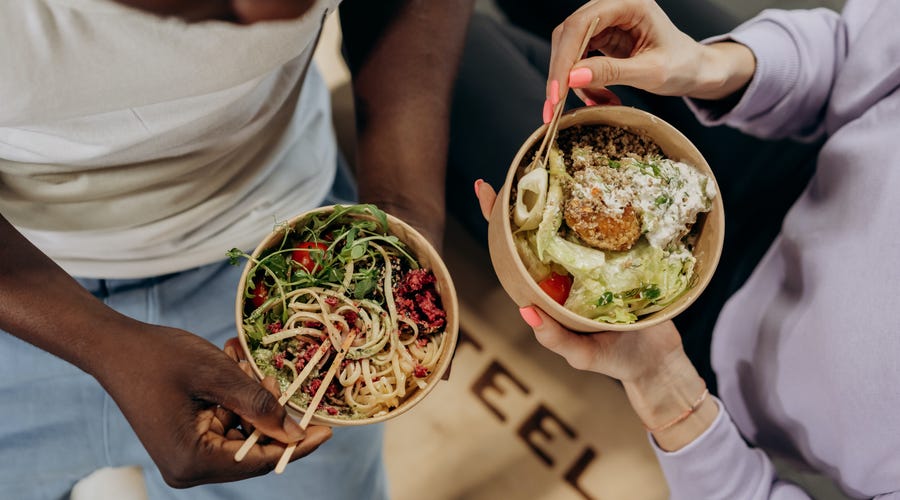
143 tasty vegetables in German to increase the flavor in your vocab
Author: Marie Schmoll
While German restaurants in the US tend to focus on the meat-heavy traditional Bavarian kitchen of the South, contemporary German cuisine is actually very veggie friendly!
Over the last ten years, Germany has constantly been ranked in the top 5 countries with the most vegans and vegetarians worldwide. So if you meet a group of Germans, especially if they’re a little younger, there’s a high chance at least a couple of them are vegetarians - and they might wanna talk about veggies, so you better be prepared!
When you’re learning German, you may not get around learning the entirety of all the vegetables in German, as well. So, we’re here to help and to show you that there’s more to German cuisine than potatoes and sauerkraut!
Free German vegetables poster
Print out this free and fun vegetables poster and stick it on your fridge. If you can memorize this list of some of the more popular vegetables in German, you'll be on your way to sounding like a local.
Vegetables in German
We grouped a wide range of veggies into various loose categories, from the popular roots and tubers, over the pretty flower vegetables to the nutritious seeds. The lines between some of these groups can be blurry as there are so many of them.
Keep in mind that there is actually no plural form for vegetables in German though. The German word “Gemüse” is a singular-only word like the English “information”. So even if you have a whole stew full of them, it will always just be “Gemüse”.
The “Gem” in “Gemüse” is pronounced just like the English word “gym”, but with a low “g” like the one in “garlic”. This is followed by the famous whistling u-sound called “ü”, and it ends in a “se”, which sounds just like a German with a thick accent would pronounce the English “the”.
So many letters, we know! If you’re still unsure about any of them, feel free to refer to our beginner’s guide to the German alphabet.
Root vegetables in German
Root vegetables are a broad category that includes all the vegetables growing underground, which are some of the most colorful vegetables you’ll find, including bright orange carrots and dark purple beetroot.

| English | German | Pronunciation |
|---|---|---|
| Beetroot | Rote Beete | [ˌʁoːtə ˈbeːtə] |
| Carrot | Karotte | [kaˈʁɔtə] |
| Celery | Sellerie | [ˈzɛləʁi] |
| Daikon Radish | Daikon-Rettich | [ˈdaɪ̯kɔn ˈʁɛtɪç] |
| Parsley root | Petersilienwurzel | [petɐˈziːli̯ən ˈvʊʁt͡sl̩] |
| Parsnip | Pastinake | [pastiˈnaːkə] |
| Radish | Radieschen | [ʁaˈdiːsçən] |
| Salsify root | Bocksbart | [ˈbɔksˌbaːɐ̯t] |
| Swede | Steckrübe | [ˈʃtɛkˌʁyːbə] |
| Turnip | Rübe | [ˈʁyːbə] |
| Yucca | Yucca | [ˈjʊka] |
| Rutabaga | Kohlrübe | [ˈkoːlˌʁyːbə] |
| Black cumin | Schwarzkümmel | [ˈʃvaʁt͡sˌkʏml̩] |
| Dandelion | Löwenzahn | [ˈløːvn̩ˌt͡saːn] |
| Maca root | Maca-Wurzel | [mɐˈsɐ̃ ˈvʊʁt͡sl̩] |
| Parsley root | Petersilienwurzel | [petɐˈziːli̯ən ˈvʊʁt͡sl̩] |
| Earthnut | Erdnuss-Platterbse | [ˈeːɐ̯tˌnʊs platˈɛʁpsə] |
Tuber vegetables in German
Tuber vegetables include the classic potato, but also some newcomers like taro or ube, which are especially popular as boba tea or ice-cream flavors and known for their instagrammable purple color.

| English | German | Pronunciation |
|---|---|---|
| Potato | Kartoffel | [kaʁˈtɔfl̩] |
| Sweet potato | Süßkartoffel | [ˈzyːskaʁˌtɔfl̩] |
| Cassava | Maniok | [maˈni̯ɔk] |
| Jerusalem artichoke | Jerusalemartischocke | [ʒe.ry.za.lɛm aʁtiˈʃɔkə] |
| Yam | Yamswurzel | [ˈjamsˌvʊʁt͡sl̩] |
| Taro | Taro | [ˈtaːʁo] |
| Ube | Wasseryams | [ˈvasɐ jams] |
| Ulluco | Ulluco | [ʊlʊko] |
Bulb vegetables in German
Bulb vegetables get their name from their bulb-like shapes, with a round bottom and a slim neck, like garlic or fennel.
They’re typically not eaten by themselves, but rather mixed into complex dishes as flavor enhancers.
| English | German | Pronunciation |
|---|---|---|
| Garlic | Knoblauch | [ˈknoːpˌlaʊ̯x] |
| Elephant Garlic | Elefantenlauch | [eleˈfantn̩ laʊ̯x] |
| Fennel | Fenchel | [ˈfɛnçl̩] |
| Common onion | Küchenzwiebel | [ˈkʏçn̩ ˈt͡sviːbl̩]] |
| Scallion | Frühlingszwiebel | [ˈfʁyːlɪŋs ˈt͡sviːbl̩] |
| Pearl onion | Perlzwiebel | [ˈpɛʁlˈt͡sviːbl̩] |
| Leek | Lauch | [laʊ̯x] |
| Wild garlic | Bärlauch | [ˈbɛːɐ̯ˌlaʊ̯x] |
| Ball-headed onion | Kugelköpfiger Lauch | [ˈkuːɡl̩kœp͡fɪɡɐ laʊ̯x] |
| Giant onion | Riesen-Lauch | [ˈʁiːzn̩ laʊ̯x] |
| Shallot | Schalotte | [ʃaˈlɔtə] |
| Chive | Schnittlauch | [ˈʃnɪtˌlaʊ̯x] |
| Kurrat | Porree | [ˈpɔʁeː] |
| Water chestnut | Wasserkastanie | [ˈvasɐkasˈtaːni̯ə] |
Stems and shoots in German
This group consists of all those long, skinny veggies we hated as kids, but soon realized can be delicious. An especially popular one in Germany is white asparagus.
During asparagus season, which usually starts in mid-April and lasts until June, little signs pop up around the country advertising fresh “Spargel”. A true sign that it’s spring in Germany!

| English | German | Pronunciation |
|---|---|---|
| Asparagus | Spargel | [ˈʃpaʁɡl̩] |
| Rhubarb | Rhabarber | [ʁaˈbaʁbɐ] |
| Swiss chard | Mangold | [ˈmaŋɡɔlt] |
| Heart of Palm | Palmenherz | [ˈpalmən hɛʁt͡s] |
| Bamboo shoot | Bambussprosse | [ˈbambʊsˌʃpʁɔsə] |
| Brussels Sprout | Rosenkohl | [ˈʁoːzn̩ˌkoːl] |
| Lettuce | Kopfsalat | [ˈkɔp͡fzaˌlaːt] |
| Fiddlehead | Becherfarn | [ˈbɛçɐfaʁn] |
| Lemongrass | Zitronengras | [t͡siˈtʁoːnənˌɡʁaːs] |
| Kohlrabi | Kohlrabi | [koːlˈʁaːbi] |
| Pikopiko | Pikopiko | [pikopiko] |
Flower vegetables in German
Almost as pretty as a flower bouquet are veggies like broccoli and cauliflower. Right?
These are in fact edible flowers, just like lotus or moringa, which are often used in fragrances for their delicious scents.

| English | German | Pronunciation |
|---|---|---|
| Broccoli | Brokkoli | [ˈbʁoːkoli] |
| Broccolini | Broccolini | [ˈbʁoːkoliniː] |
| Cauliflower | Blumenkohl | [ˈbluːmənkoːl] |
| Romanesco | Romanesco | [ʁomaˈnɛsko] |
| Artichoke | Artischocke | [aʁtiˈʃɔkə] |
| Choi sum | Choi sum | [ˈtʃɔɪ̯ t͡sʊm] |
| Agati | Turiblüte | [ˈtuːʁiˈblyːtə] |
| Asian pigeonwing | Schamblume | [ʃaːmˈbluːmə] |
| Lotus | Lotus | [ˈloːtʊs] |
| Zucchini | Zucchini | [t͡sʊˈkiːni] |
| Squash blossom | Kürbisblüte | [ˈkʏʁbɪsˈblyːtə] |
| Banana heart / blossom | Bananenblüte | [baˈnaːnənblyːtə] |
| Caper | Kaper | [ˈkaːpɐ] |
| Daylily | Taglilie | [ˈtaːkˌliːli̯ə] |
| Jade vine | Jadewein | [ˈjaːdəˈvaɪ̯n] |
| Loroco | Loroco | [lɔʁˈʁɔko] |
| Moringa | Wunderbaum | [ˈvʊndɐbaʊ̯m] |
Fungi and mushrooms in German
Did you know that mushrooms aren’t actually plants? They’re not quite animals either. They’re fungi and therefore their own species, which is somewhere in between.
While plants make their own food by transforming light energy from the sun into nutrients through photosynthesis, and animals eat foods (just like us), fungi do neither of those things. They feed by absorbing the nutrients of their immediate environment, which is why they only grow on nutritious grounds.

| English | German | Pronunciation |
|---|---|---|
| Mushroom | Pilz | [pɪlt͡s] |
| Fungus | Fungus | [ˈfʊŋɡʊs] |
| Champignon | Champignon | [ˈʃampɪnjɔŋ] |
| Portobello | Portobello | [ˈpɔʁtobɛllo] |
| Porcini | Steinpilz | [ˈʃtaɪ̯nˌpɪlt͡s] |
| Girolle | Pfifferling | [ˈp͡fɪfɐlɪŋ] |
| Shiitake | Shiitake | [ʃiiˈtaːkə] |
| Milkcap | Milchling | [mɪlçˈlɪŋ] |
| Morel | Morchel | [ˈmɔʁçl̩] |
| Changeable pholiota | Gemeines Stockschwämmchen | [ɡəˌmaɪ̯nəs ˈʃtɔkˌʃvɛmçən] |
| Oyster mushroom | Austernpilz | [ˈaʊ̯stɐnˌpɪlt͡s] |
| Black trumpet | Herbsttrompete | [ˈhɛʁpsttʁɔmpeːtə] |
| Enoki | Enoki, Samtfußrübling | [ˈzamtfuːsʁyːplɪŋ] |
| Truffles | Trüffel | [ɛnoːki] |
Leaves in German
Leaf vegetables or pot herbs generally stem from herbaceous plants with short lifespans and a rich nutritious palate, like lettuce or spinach. Many of them are used as seasonings or sprinkled on top of dishes for extra flavor.

| English | German | Pronunciation |
|---|---|---|
| Arugula | Rucola | [ˈʁʊkoːlɑ] |
| Kale | Grünkohl | [ˈɡʁyːnˌkoːl] |
| Bok choy | Pak Choi | [pɑk ˈtʃɔɪ̯] |
| Ong choy | Ong choi | [ʔawŋ͡m ˈtʃɔɪ̯] |
| Yen choy | Yen choi | [jɛn ˈtʃɔɪ̯] |
| Collard greens | Blattkohl | [blatkoːl] |
| Dandelion | Löwenzahn | [ˈløːvn̩ˌt͡saːn] |
| Rapini (broccoli raab) | Rübstiel | [ˈʁyːbʃtiːl] |
| Mustard greens | Brauner Send | [ˈbʁaʊ̯nɐ ˈzɛnf] |
| Cabbage | Kohl | [koːl] |
| Cavolo nero | Palmkohl | [ˈpalmkoːl] |
| Pūhā | Gänsedistel | [ˈɡɛnzəˈdɪstl̩] |
| Radicchio | Radicchio | [ʁaˈdɪki̯o] |
| Sorrel | Sauerampfer | [ˈzaʊ̯ɐˌʔamp͡fɐ] |
| Spinach | Spinat | [ʃpiˈnaːt] |
| Watercress | Brunnenkresse | [ˈbʁʊnənkʁɛsə] |
| Witloof | Chicoree | [ˈʃɪkoʁe] |
| Amaranth | Amarant | [amaˈʁant] |
| Fenugreek | Bockshornklee | [ˈbɔkshɔʁnˌkleː] |
| Coriander | Koriander | [koˈʁi̯andɐ] |
| Basil | Basilikum | [baˈziːlikʊm] |
| Dill | Dill | [dɪl] |
| Mint | Minze | [ˈmɪnt͡sə] |
| Rosemary | Rosmarin | [ˈʁoːsmaˌʁiːn] |
| Oregano | Oregano | [oˈʁeːɡano] |
| Thyme | Thymian | [ˈtyːmi̯aːn] |
| Sage | Salbei | [ˈzalbaɪ̯] |
| Bay Leaf | Lorbeer | [ˈlɔʁˌbeːɐ̯] |
“Fruit” vegetables in German
Fruits develop from the flower of a plant and therefore have seeds, while vegetables develop from all other parts of the plants and consist of roots, stems and leaves.
Yet, many fruits are often mistaken for vegetables, such as tomatoes and eggplants. Here’s a list of fruits, often falsely posing as vegetables.

| English | German | Pronunciation |
|---|---|---|
| Plantain | Kochbanane | [ˈkɔxbaˌnaːnə] |
| Pumpkin | Kürbis | [ˈkʏʁbɪs] |
| Squash | Speisekürbis | [ˈʃpaɪ̯zəkʏʁbɪs] |
| Spaghetti squash | Spaghettikürbis | [ʃpaˈɡɛtikʏʁbɪs] |
| Cucumber | Gurke | [ˈɡʊʁkə] |
| Bell pepper | Paprikaschote | [ˈpapʁikaˌʃoːtə] |
| Tomato | Tomate | [toˈmaːtə] |
| Tomatillo | Tomatillo | [toˈmaːtɪlo] |
| Chilli | Chili | [ˈtʃiːli] |
| Okra | Okra | [ˈɔkʁa] |
| Chayote, Choko | Chayote | [/tʃɑˈjoʊti] |
| Tindora | Tindola | [ˈtîːnidoːla] |
| Bitter melon | Bittergurke | [ˈbɪtɐˈɡʊʁkə] |
| Fuzzy melon | Wintermelone | [ˈwɪntɚmeˈloːnə] |
| Eggplant | Aubergine | [obɐˈʒiːnə] |
| Lauki | Flaschenkürbis | [ˈflaʃn̩ˈkʏʁbɪs] |
Seeds (legumes) in German
Seeds are at the heart of a vegetable. They hold genetic information and are therefore crucial for the plant species’ survival. They’re also extra nutritious!
| English | German | Pronunciation |
|---|---|---|
| Beans | Bohnen | [ˈboːnən] |
| Kidney Beans | Kidneybohnen | [ˈkɪtniˌboːnən] |
| Pinto beans | Pintobohnen | [pɪntɔboːnən] |
| Soybeans | Sojabohnen | [ˈzoːjaˌboːnən] |
| Black Beans | Schwarze Bohnen | [ˈʃvaʁt͡sə ˈboːnən] |
| Mung Beans | Mungbohnen | [ˈmʊŋɡoboːnən] |
| Navy Beans | Weiße Bohnen | [ˈvaɪ̯sə ˈboːnən] |
| Broad beans | Saubohnen | [ˈzaʊ̯boːnən] |
| Lima beans | Limabohnen | [ˈliːmaboːnən] |
| Lentils | Linsen | [ˈlɪnzn̩] |
| Peas | Erbsen | [ˈɛʁpsn̩] |
| Chickpeas | Kichererbsen | [ˈkɪçɐˌʔɛʁpsn̩] |
| Black-eyed peas | Schwarzaugenbohnen | [ʃvaʁt͡sˈaʊ̯ɡn̩boːnən] |
| Snow peas | Kaiserschoten | [ˈkaɪ̯zɐˈʃoːtn̩] |
| Peanuts | Erdnüsse | [ˈeːɐ̯tˌnʏsə] |
| Edamame | Edamame | [e̞da̠ma̠me̞] |
| Sugar snaps | Zuckerschote | [ˈt͡sʊkɐˈʃoːtə] |
| Sweetcorn | Zuckermais | [ˈt͡sʊkɐmaɪ̯s] |
Helpful tips on learning the vegetables in German
Watch German cooking shows
One fun way to extend your German vegetable word pool is to watch some German cooking shows. As you see what the chefs are doing, you’ll recognize the vegetables they name. Watching TV shows in German to learn the language is a wide-spread and fun method. It’s also one of many neat tricks used by many polyglots, who manage to learn at least three foreign languages!
Find recipes online
The internet is a great resource for recipes from all over the world. Look for German results of recipes specifically and see how well you understand them.
Not only will you be able to test and extend your food-related German knowledge that way - you’ll also learn a lot about German cuisine, which is an integral part of German culture.
Found a German recipe that sounds intriguing? Try it out!
Incorporate all of your senses
Using your whole body is proven to help you learn languages more easily. One excellent way to move your body and incorporate all your senses, while you learn new words, is to cook.
- Grab a fresh “Blumenkohl” and feel the florets, as you break them off;
- Smell the “Rosmarin” before you sprinkle it over your dish.
If you practice your German vegetables while cooking, they’re a lot likelier to stick.
Laber rhabarber
There’s a German expression to use when someone is either making up stories or just won’t stop talking: “Laber rhabarber!” It translates to “Babber rhubarb!”, which indicates that whatever the other one is saying is not being appreciated. It can also be used as an apology if you realize you’re talking and talking, very similar to the ever-popular “blah blah blah”.
The saying hints at the idea that talking vegetables is not really saying anything at all, and that’s fine! Being able to talk about vegetables means you can soon talk about your favorite foods, share recipes and learn about the country’s cuisine - a safe and easy starting point for small talk. (That is, after you’ve mastered German greetings and thanking people in German!)
When we learn a foreign language, it’s exactly these kinds of topics that we need to master before we’re ready to jump into philosophy or world politics! So embrace the journey and keep expanding your vocabulary via our free German vocabulary blog article lessons.



